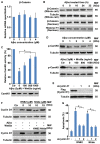Wnt5a Promotes Cortical Neuron Survival by Inhibiting Cell-Cycle Activation
- PMID: 29033786
- PMCID: PMC5626855
- DOI: 10.3389/fncel.2017.00281
Wnt5a Promotes Cortical Neuron Survival by Inhibiting Cell-Cycle Activation
Abstract
β-Amyloid protein (Aβ) is thought to cause neuronal loss in Alzheimer's disease (AD). Aβ treatment promotes the re-activation of a mitotic cycle and induces rapid apoptotic death of neurons. However, the signaling pathways mediating cell-cycle activation during neuron apoptosis have not been determined. We find that Wnt5a acts as a mediator of cortical neuron survival, and Aβ42 promotes cortical neuron apoptosis by downregulating the expression of Wnt5a. Cell-cycle activation is mediated by the reduced inhibitory effect of Wnt5a in Aβ42 treated cortical neurons. Furthermore, Wnt5a signals through the non-canonical Wnt/Ca2+ pathway to suppress cyclin D1 expression and negatively regulate neuronal cell-cycle activation in a cell-autonomous manner. Together, aberrant downregulation of Wnt5a signaling is a crucial step during Aβ42 induced cortical neuron apoptosis and might contribute to AD-related neurodegeneration.
Keywords: Alzheimer’s disease; Cyclin D1; Wnt5a; apoptosis; cell-cycle activation; cortical neuron; β-Amyloid protein.
Figures







Similar articles
-
The regulation of p53 up-regulated modulator of apoptosis by JNK/c-Jun pathway in β-amyloid-induced neuron death.J Neurochem. 2015 Sep;134(6):1091-103. doi: 10.1111/jnc.13128. Epub 2015 Apr 28. J Neurochem. 2015. PMID: 25891762
-
The protective effect of curcumin on Aβ induced aberrant cell cycle reentry on primary cultured rat cortical neurons.Eur Rev Med Pharmacol Sci. 2012 Apr;16(4):445-54. Eur Rev Med Pharmacol Sci. 2012. PMID: 22696871
-
Roles of Id1/HIF-1 and CDK5/HIF-1 in cell cycle reentry induced by amyloid-beta peptide in post-mitotic cortical neuron.Biochim Biophys Acta Mol Cell Res. 2020 Apr;1867(4):118628. doi: 10.1016/j.bbamcr.2019.118628. Epub 2019 Dec 26. Biochim Biophys Acta Mol Cell Res. 2020. PMID: 31884068
-
The Wnt pathway, cell-cycle activation and beta-amyloid: novel therapeutic strategies in Alzheimer's disease?Trends Pharmacol Sci. 2003 May;24(5):233-8. doi: 10.1016/s0165-6147(03)00100-7. Trends Pharmacol Sci. 2003. PMID: 12767722 Review.
-
Vicious cycles within the neuropathophysiologic mechanisms of Alzheimer's disease.Curr Alzheimer Res. 2006 Apr;3(2):95-108. doi: 10.2174/156720506776383068. Curr Alzheimer Res. 2006. PMID: 16611010 Review.
Cited by
-
The Wnt/Ca2+ pathway is involved in interneuronal communication mediated by tunneling nanotubes.EMBO J. 2019 Dec 2;38(23):e101230. doi: 10.15252/embj.2018101230. Epub 2019 Oct 18. EMBO J. 2019. PMID: 31625188 Free PMC article.
-
Effects of Wnt5a overexpression in spinal cord injury.J Cell Mol Med. 2021 Jun;25(11):5150-5163. doi: 10.1111/jcmm.16507. Epub 2021 May 3. J Cell Mol Med. 2021. PMID: 33939286 Free PMC article.
-
Synergistic effects of epigallocatechin gallate and l-theanine in nerve repair and regeneration by anti-amyloid damage, promoting metabolism, and nourishing nerve cells.Front Nutr. 2022 Aug 10;9:951415. doi: 10.3389/fnut.2022.951415. eCollection 2022. Front Nutr. 2022. PMID: 36034895 Free PMC article.
-
Neurons and Astrocytes Elicit Brain Region Specific Transcriptional Responses to Prion Disease in the Murine CA1 and Thalamus.Front Neurosci. 2022 May 16;16:918811. doi: 10.3389/fnins.2022.918811. eCollection 2022. Front Neurosci. 2022. PMID: 35651626 Free PMC article.
-
Neuronal Cell Death Mechanisms in Major Neurodegenerative Diseases.Int J Mol Sci. 2018 Oct 9;19(10):3082. doi: 10.3390/ijms19103082. Int J Mol Sci. 2018. PMID: 30304824 Free PMC article. Review.
References
LinkOut - more resources
Full Text Sources
Other Literature Sources
Research Materials

